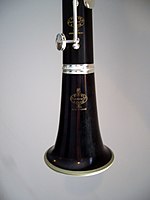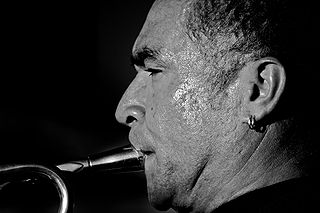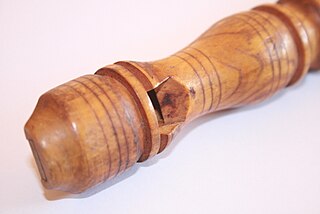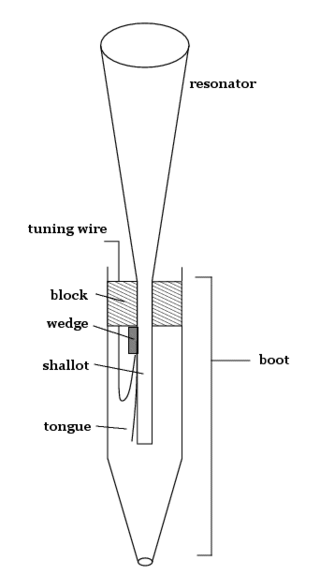Physics of sound production
Sound production in all wind instruments depends on the entry of air into a flow-control valve attached to a resonant chamber (resonator). The resonator is typically a long cylindrical or conical tube, open at the far end. A pulse of high pressure from the valve will travel down the tube at the speed of sound. It will be reflected from the open end as a return pulse of low pressure. Under suitable conditions, the valve will reflect the pulse back, with increased energy, until a standing wave forms in the tube.
Reed instruments such as the clarinet or oboe have a flexible reed or reeds at the mouthpiece, forming a pressure-controlled valve. An increase in pressure inside the chamber will decrease the pressure differential across the reed; the reed will open more, increasing the flow of air. [2] [3] The increased flow of air will increase the internal pressure further, so a pulse of high pressure arriving at the mouthpiece will reflect as a higher-pressure pulse back down the tube. Standing waves inside the tube will be odd multiples of a quarter-wavelength, [4] with a pressure anti-node at the mouthpiece, and a pressure node at the open end. The reed vibrates at a rate determined by the resonator.
For Lip Reed (brass) instruments, the players control the tension in their lips so that they vibrate under the influence of the air flowing through them. [5] [6] They adjust the vibration so that the lips are most closed, and the air flow is lowest, when a low-pressure pulse arrives at the mouthpiece, to reflect a low-pressure pulse back down the tube. Standing waves inside the tube will be odd multiples of a quarter-wavelength, with a pressure anti-node at the mouthpiece, and a pressure node at the open end.
For Air Reed (flute and fipple-flute) instruments, the thin grazing air sheet (planar jet) flowing across an opening (mouth) in the pipe interacts with a sharp edge (labium) to generate sound. [7] The jet is generated by the player, when blowing through a thin slit (flue). For recorders and flue organ pipes this slit is manufactured by the instrument maker and has a fixed geometry. In a transverse flute or a pan flute the slit is formed by the musicians between their lips.
Due to acoustic oscillation of the pipe the air in the pipe is alternatively compressed and expanded. [8] This results in an alternating flow of air into and out of the pipe through the pipe mouth. The interaction of this transversal acoustic flow with the planar air jet induces at the flue exit (origin of the jet) a localised perturbation of the velocity profile of the jet. This perturbation is strongly amplified by the intrinsic instability of the jet as the fluid travels towards the labium. This results into a global transversal motion of the jet at the labium.
The amplification of perturbations of a jet by its intrinsic instability can be observed when looking at a plume of cigarette smoke. Any small amplitude motion of the hand holding the cigarette results into an oscillation of the plume increasing with distance upwards and eventually a chaotic motion (turbulence). The same jet oscillation can be triggered by gentle air flow in the room, which can be verified by waving with the other hand.
The oscillation of the jet around the labium results into a fluctuating force of the airflow on the labium. Following the third law of Newton the labium exerts an opposite reaction force on the flow. One can demonstrate that this reaction force is the source of sound that drives the acoustic oscillation of the pipe.
A quantitative demonstration of the nature of this type of sound source has been provided by Alan Powell [9] when studying a planar jet interacting with a sharp edge in the absence of pipe (so called edgetone). The sound radiated from the edgetone can be predicted from a measurement of the unsteady force induced by the jet flow on the sharp edge (labium). The sound production by the reaction of the wall to an unsteady force of the flow around an object is also producing the aeolian sound of a cylinder placed normal to an air-flow (singing wire phenomenon). In all these cases (flute, edgetone, aeolian tone...) the sound production does not involve a vibration of the wall. Hence the material in which the flute is made is not relevant for the principle of the sound production. There is no essential difference between a golden or a silver flute. [10]
The sound production in a flute can be described by a lumped element model in which the pipe acts as an acoustic swing (mass-spring system, resonator) that preferentially oscillates at a natural frequency determined by the length of the tube. The instability of the jet acts as an amplifier transferring energy from the steady jet flow at the flue exit to the oscillating flow around the labium. The pipe forms with the jet a feedback loop. These two elements are coupled at the flue exit and at the labium. At the flue exit the transversal acoustic flow of the pipe perturbs the jet. At the labium the jet oscillation results in a generation of acoustic waves, which maintain the pipe oscillation.
The acoustic flow in the pipe can for a steady oscillation be described in terms of standing waves. These waves have a pressure node at the mouth opening and another pressure node at the opposite open pipe termination. Standing waves inside such an open-open tube will be multiples of a half-wavelength. [4]
To a rough approximation, a tube of about 40 cm. will exhibit resonances near the following points:
- For a reed or lip-reed instrument: 220 Hz (A3), 660 Hz (E5), 1100 Hz (C#6).
- For an air-reed instrument: 440 Hz (A4), 880 Hz (A5), 1320 Hz (E6).
In practice, however, obtaining a range of musically useful tones from a wind instrument depends to a great extent on careful instrument design and playing technique.
The frequency of the vibrational modes depends on the speed of sound in air, which varies with air density. A change in temperature, and only to a much smaller degree also a change in humidity, influences the air density and thus the speed of sound, and therefore affects the tuning of wind instruments. The effect of thermal expansion of a wind instrument, even of a brass instrument, is negligible compared to the thermal effect on the air.

















